#plant care
Text
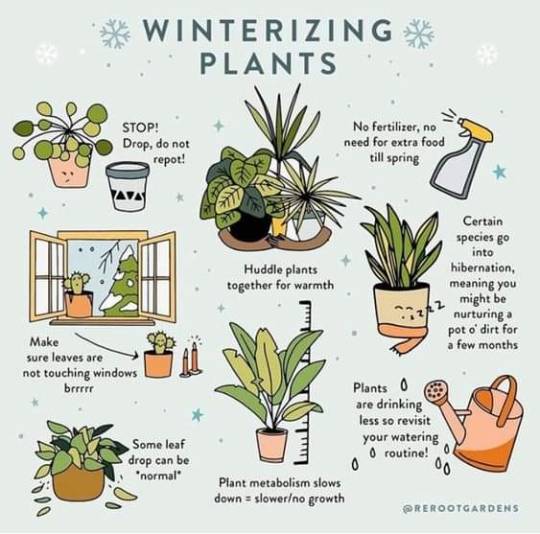
🌲🌿🪴🌻🪷🍂🌳
#plant witch#plantcore#plantblr#plants#plant care#witchy vibes#nature#green witch#witchythings#witchblr#baby witch tips#witch community#witch blog#beginner witch#witch aesthetic#forest witch#green witchcraft#nature witch#witches of tumblr#witch tips#witchy stuff
293 notes
·
View notes
Text

🐝 Just my spooky self, my cat and my plants 🪴
#goth#goth memes#plant memes#plantlife#house plant#plant care#plantcore#trending memes#trending#goth art#spooky cute#spooky art#spooky aesthetic#plant mom#plant dad#plant parent#plantlover#plant community#house plants#mental health#healing#self love#my hobby#hobbies#calming#calming hobbies#cute ghost#art
226 notes
·
View notes
Text
plant care masterpost ⋆˚✿˖°

part 1
Types of Plants:
plants come in all shapes and sizes and each plant has specific needs! so here's some quick tips to keep in mind while picking out a little plant friend!
a general rule of thumb when choosing a plant is considering how the plant thrives in it's natural habitat and providing that with your care, whether it's in a sunny spot in your window or in your garden outside.
Succulents and Cacti need more sun and dry conditions than tropical plants that enjoy more wet and humid conditions. keep this in mind while growing many different types at once!
if growing plants in a terrarium make sure there is plenty of light and air circulation to prevent moisture buildup and rot. do not seal the plants inside! you'll want to be able to remove them in case they get sick.
all plants have unique grow-times and dormant periods. for example plants native to the northern hemisphere go dormant (hibernate) while plants in the southern hemisphere are growing, and vice-versa.
plants in their peak grow-time require more water and care than dormant ones.
some tropical plants have very specific needs; like staghorns, orchids and air plants so I recommend researching those thoughroughly before getting one.
I don't have a lot of experience with trees, fruits and vegetables so I'm skipping those for now.
Watering:
the amount of water a plant needs depends mostly on what type of plant it is and which climate it's in. remember that growing plants need more water and dormant plants need less!
plants only drink when they're awake! roots are most active during the daytime so water your plants in the morning, afternoon or evening. watering at night will cause too much water to sit in the pot and will rot the roots.
tropical plants are picky needy guys and enjoy very damp, humid, rainforest-like conditions. humidifiers help keep moisture in the air as well as routine misting with a waterbottle, just make sure there's proper ventilation so the plants aren't too wet for too long.
arid plants like succulents and cacti are pros at storing water and need less watering than other plants. (I water mine every 2 weeks. 3 weeks in the winter.)
no plant likes having wet feet! make sure your pots and containers have drainage holes to allow airflow to the roots and so excess water can escape.
it's always better to under water than to overwater! it's easier to save a dried-up plant than a rotten one. so if your plant seems sick it's better to hold off on watering it for a while.
most plants die from getting too much water! overwatering leads to rot, infections, mold, and even attracts bugs! it's a bad time! so only water your plants when the soil is dry and make sure there's proper drainage.
an overwatered plant will look sickly. it might turn yellow or pale, drop it's leaves, or be squishy to the touch. some plants like succulents or cacti may have swollen, cracked stems from absorbing too much water.
an underwatered plant will look droopy and the leaves will feel dry, crispy or wrinkled. water the plant throughroughly until water drains out of the bottom of the container and give it some time to recover. if your plant is severely dehydrated you might want to completely soak it, spraying the entire plant and putting the pot in a basin or tray of water so it can absorb water as needed.
Soil:
the type of soil depends on the type of plant, but all plants require nutrients in order to grow. it's important to use well-draining soil and provide airflow to the roots.
typically you want soil that's a mix of organic matter and grit (like pumice or lava rock.) the organic matter provides nutrients while grit helps keep the soil loose so it doesn't compact and rot the roots while watering.
(I've been using Bonsai Jack's gritty mix for years and I swear by the stuff.)
keep in mind that thick, organic soil holds water longer than a loose, gritty mix and takes longer to dry out so you should water your plants less.
likewise, gritty mix drains faster and may require more watering, especially in the summer.
seedlings require more nutrients and have less developed roots so highly organic soils or coco coir works best.
(more organic matter = more prone to rot though so be careful!)
worms are friends. like seriously. earthworms in your pots are a good thing!
not only does it mean your soil is rich in nutrients plants love, but worm tunnels help create air pockets in the soil so your plant's roots can breathe easier and helps prevents rot. they won't hurt your plant at all and only eat decomposing matter. if you don't want them in your house though they'll do wonders for your garden!
123 notes
·
View notes
Text

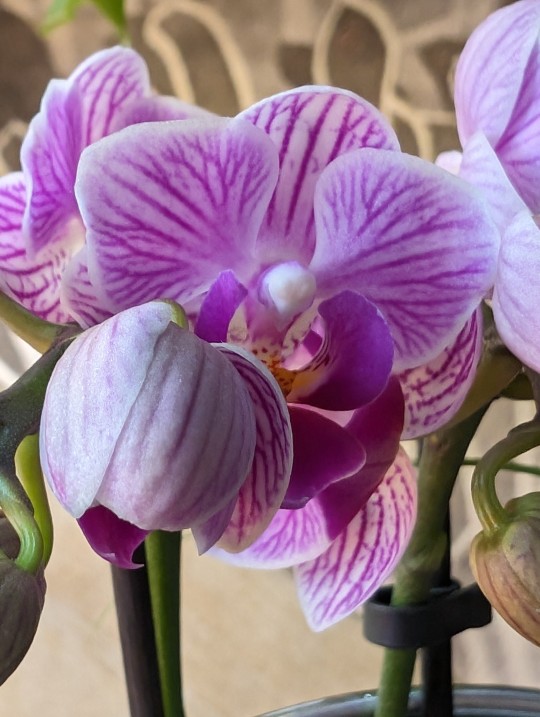
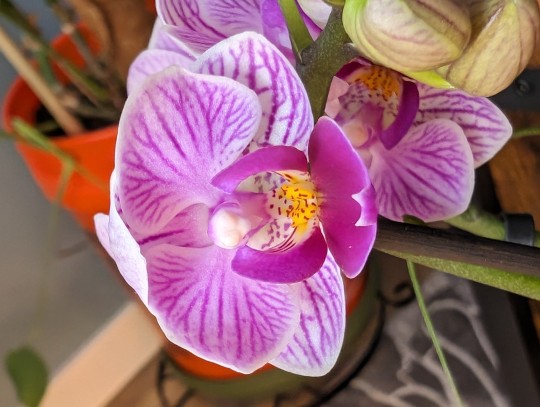
Baby's first orchid! I got it at the grocery store. Gonna see if I can keep this one alive before I invest in anything more exotic and expensive.
I was told "treat it like an air plant" so the orchid gets the Monday soak with the rest of the tillandsia.
January 2024
66 notes
·
View notes
Text
How not to over-water your plants
So, firstly, if you're new to plants, you might be wondering, well what is so bad about over watering? After all, they're plants aren't they? Don't they need water to survive? The more the merrier? And to you I say, good point, here's why it can work with plants outside, but not plants in little pots inside.
Have you ever left a piece of organic matter in the water? Like, a leaf, or even a flower in a flower vase. If you left it in for a week, it develops a bad smell, and the leaves, stems and roots will start to degrade, ferment, and rot in the water. That's exactly what's happening to the roots of your houseplants if they're left in an overly-wet soil; they don't have any access to oxygen, and they rot. Outside, the soil is constantly draining the water further down, the earth is capable of absorbing a lot of water while leaving the topsoil pleasantly damp, but not liquid with water. So you need to make sure your soil is never so wet that it rots your plants roots; if it comes to that, your plant will start turning brown or black, become squishy and spongy, and eventually rot completely.
So how do you avoid it? You'll often hear advice about 'having good drainage', which means your pot needs to have little holes for the water to come out, and the soil shouldn't be so dense and clayish that it would stop water from draining through. However, even if you have perfect drainage, you can still pour in so much water that the little tray under the pot is filled with water – thus the plants sit in water again, rotting. It's difficult to see whether the soil is saturated with water too, sometimes the top of the soil can seem completely dry and you don't see if it's all the way dry or not, it can be misleading. You also can't just stick to a watering schedule because the soil dries out at different speed, based on humidity, heating, temperature, season, exposure to sunlight, it will be different every time. So how can you get around this problem?
The solution I found works perfectly is: lift the pot. As soon as you feel the weight of the pot in your hands, you'll be able to tell whether that thing is heavy as if it's filled with water, or if it's so light that there's barely any water in it. If your pot is super heavy and feels like you just lifted a bucket of water, leave it be, do not water it for a week, until it becomes a normal weight (it should feel like one third of it is water). If your pot is so light, that it feels like nothing is in it at all, then you need to water enough to fill that entire tray underneath, and then let the soil absorb the water for a while. If the soil is super dry, it becomes hydrophobic, and it will take time for it to start absorbing water again; but don't worry, if you leave it sitting in water overnight, it should be fine again, and the plants won't start to rot after just one day of sitting water. A normal watering should be just one third of the container of the plant, that should saturate the soil so it's damp, but not dripping with water.
A further step you can take to make sure your plants are happy with the amount of water, is to research the plants themselves, and how they like to be watered. Most plants will do well on having their soil pleasantly damp, but some houseplants like to have their soil dry out completely before they get a good amount of water again; for instance, lemon trees like that feeling of being dried completely, and then being watered generously, because they're used to growing in tropical areas, and going through droughts and rainfall. Some plants are capable of taking moisture from the air, but they still love having a good amount of water in the pot. Nothing will give you better insight than researching every plant separately.
So what about succulents? You may have been told that you can ignore succulents and they'll be fine, however I found this not to be true, after my poor neglected succulent died due to non watering. You can't even use the trick of lifting the pot, if you're having succulents and aloe vera, because those plants keep water inside of their bodies, so if you lift the pot, it might be heavy, not because it's filled with water, but because the plants themselves are heavier, keeping water inside of themselves. They absolutely need water too, there's just a difference in how long they can do without it. But we're not trying to give those plants endurance tests, we're trying to make sure they're happy and thriving. So how to know when to water your succulents or aloe vera?
The solution is: you try to see if they're squishy. A succulent happily filled with water, will be firm and sturdy to touch. If your succulent is starting to dry, and is now spending the water they have in their inside store, they'll become squishy! If you lightly press with your fingers on the leaf, or the stem of a succulent, and it gives way and squishes, that means the plant needs more water in order to be happy. The squishiness starts closer to the base and the stem of the plant, so if you can check the widest, most base leafs, you'll get the best idea of whether they need water or not. Also, if you see any leaves on them that are dried, brown, dying away, you can pull these off! Your plants are only burdened by keeping dead plant matter on, if you pull those off the plant will immediately look healthier, have less to worry about, and be ready to grow new healthy leaves.
Any big plant can generally survive longer without water than a smaller plant, simply because they are able to store water inside of themselves, so they have some reserve. You always have to keep a closer eye on your tiniest little plants, and your giant plants will need your attention less frequently. Another tip is to have your plants somewhere you see them every day, because if your plant is somewhere you have to specifically go to see it and water it, it is likely you'll forget about its existence until it's too late. Even writing this I remembered I had some plants on a window that I don't usually use, and I've forgot to water them for two weeks. Oops. (they're fine I watered them now).
I hope these tricks help you have confidence in caring for your plants! It took me a while to figure it out, so I'm happy to share my knowledge. If you know more tricks please write them on this post so that I may become smarter too.
#plant care#houseplants#over watering#overwatering#gardening#inside plants#seedlings#i'm gonna start my seedlings soon!!!#plants#growing plants
54 notes
·
View notes
Text

#cactus#succulent#succulents and cacti#cacticollection#cactilover#cactigarden#cacti aesthetic#succulents#plants#plantblr#gardening#plant care#plant collection#plant aesthetic
104 notes
·
View notes
Text



Been a busy morning watering all the plants with my boy!
45 notes
·
View notes
Text
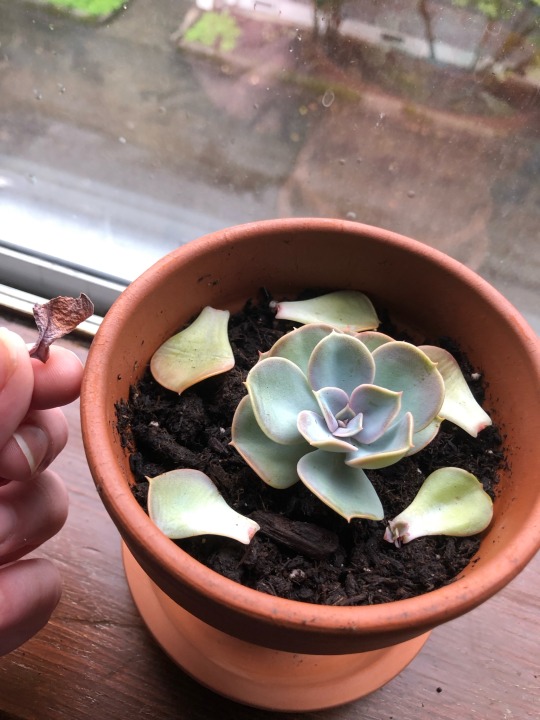
I’ve never had much of a green thumb, but I’m doing my best with this succulent. The she used to look more like a palm tree with how extended it was. I’m talking five inches tall. I learned that this means you gotta behead and replant it, as well as find a sunnier spot. I hope I didn’t just kill this baby who’s been with me since 2019, but so far It seems she’s doing really well! It used to be just a stump in the soil, and now I can’t (gently) pull it out due to all the roots it grew. I replanted in mid to late august so that’s pretty good progress! If I did it horribly wrong like I feared she would’ve withered by now.
The leaves are more of an experiment. I heard I could propagate them and in all honesty didn’t do much research on that. Judging by the control leaf (left side, in my fingers) I’m at least doing something right. If they get roots, I have a new pot ready and waiting for them.
#any advice or tips are welcomed#plantblr#succulent#her previous pot didn’t have a drainage hole or drainage soil so I fixed that with this repotting#now I don’t need to live in fear of root rot killing her#plant propagation#plant care#since the roots are short I soak the soil maybe a little too often but now since she’s officially taken root#my plan is to only giv her a good soak when the soil is dry dry.
48 notes
·
View notes
Text
So… maybe kind of a weird question but does anyone know good plants to grow if you want to garden or keep houseplants but don't always have the energy/ability to keep on top of watering schedules and such?
I'm not gonna dump my whole life story and symptom list here but tldr I am a mentally ill individual who struggles often with having the energy to do things. I get depressive episodes that can last weeks or even months which often means that I'll take super good care of a plant and it'll do really well and then I suddenly stop watering it for weeks at a time because I'm using all my energy to do basic self care/necessities. Does anyone know a way to get around that??? Either tips on how to keep plants alive through periods of neglect, or plants that don't require much maintenance?????
(If you're going to recommend any native plants, I live in east texas for reference)
rn I'm just trying to salvage the plants I have, a very wilted succulent I forgot the name of, a very small zebra plant, and a parlor palm that has survived a shocking amount of things. I probably can't save all of them but I'm doing my best.
#plants#houseplants#gardening#garden#horticulture#home garden#greenery#foliage#succulents#parlor palm#zebra plant#mental health#mental illness#disability#depressive episodes#low energy#low maintenance plants#low maintenance garden#I'd love to grow a full on garden with vegetables and fruits in my yard someday but that's kind of a far off goal for me#plant care#plantcare#plantblr
60 notes
·
View notes
Text
"Thrive on neglect" is a complete lie. You always see lists of "easy" houseplants online nowadays, often referred to as plants that "Thrive on neglect" and are "Impossible to kill." Bullshit. No houseplant I've ever encountered has been happier and healthier while being ignored than when receiving regular checks and daily attention.
There are many plant species that prefer dry soil, but infrequent watering ≠ neglect. You cannot seriously tell people that they can put a plant in a pot and just walk away and that that plant will "thrive."
Plants I see owned by people with this mentality of watering every month or two because their plant is "impossible to kill" look like they're barely clinging onto life.
Plants enjoy attention. Greet them, chat with them, play music for them, fertilise them, listen to their individual needs, and water them when they say so.
Thrive on neglect my arse
#studyblr#studying#studyspo#plantblr#house plant#plants#plant parent#plantlover#houseplants#plant rant#plant care#houseplant care#my opinion#my thoughts#idk#random#study blog#study hard#studyspiration#zoology#dark academia#study#light academia#light academism#biology#light academia aesthetic
102 notes
·
View notes
Text
human domestication guide gave me the wildest brainworms- i’m so fucking horny for and obsessed with plant care now, it’s soooo fucking intimate. Specifically what i’m frantically researching and looking into this week is closed terrariums systems & eventually acquiring some isopods to inhabit these spaces…. what have I become???
#human domestication guide#plant care#tumblr is like my little diary and a peek into my subconscious#the affini in my brain keeps encouraging me to get more plants is not where I thought reading smut would take me but here we are#terrarium
105 notes
·
View notes
Text
Lazy plant care tip:
If you're bad at remembering to water your plants, get you a plant that wilts easily when underwatered, but bounces back quickly once hydrated. As long as you're looking at your plants on a regular basis, that should remind you when to check the others for watering needs (don't just assume that they all need water at the same time).
My pothos and croton are the indoor plants I use for this.
My abutilon is the one I watch for outside plants (also just a great plant, 10/10 would recommend).
241 notes
·
View notes
Text
2024 has begun with an issue.
I have too many plants
Okay. So. We've seen my blog, right? We're familiar with what I am. When I came to uni I had 6 plants. A mystery leafed boy (don't know what it is until it flowers), a wax plant, a pothos, a spider plant, asparagus fern, and a 4 decade old Christmas cactus.
The Christmas cactus broke during the move
There are now 8 Christmas cactuses propagated from the broken branch.
And then, I buy myself a few more. I had space! A banana plant, peace lily, prayer plant, and heart leaf philodendron.
After this we started reaching... Max capacity. But you see. It didn't stop there.
My friend brought me a turtle vine and a jade plant today.
I swapped them for a Christmas cactus.
You may notice 2 - 1 does not equal 0. She has also stated that in lieu of anything else to get me for Christmas, she will get me a plant.
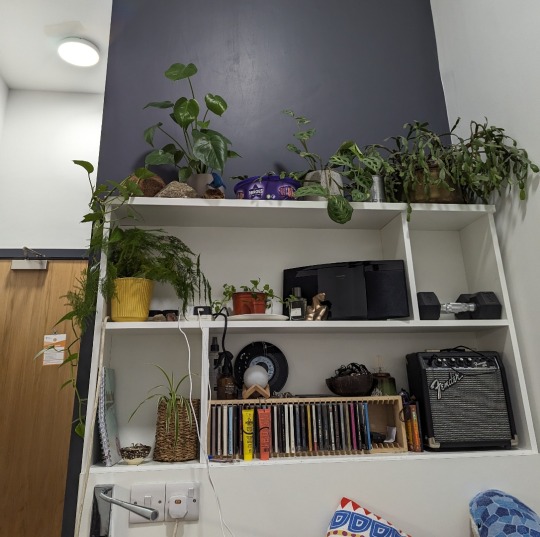
We are at a crisis point lads. How. Does. One. Unexcess. The plants.
#I LOVE ALL MY CHILDREN#I LOVE ALL MY CHILDREN SO MUCH#I LOVE THEM ALL#I DON'T WANT TOO PART WAYS WITH THEM#SOBS#mountmothrambles#plants#plant care#plantblr#<3#help
25 notes
·
View notes
Text


I made my first sorta-terrarium! It's all non-soil elements in Eve's baby tank. I put in begonias (some new some old) and the new lil sundew I made a few months ago. It's not airtight but the walls will provide some extra humidity.


#plant photography#plant blog#plants#garden#begonia#succulent#succulents#plant#terrarium#plantblr#sundew#begonias#maidenhair fern#original photographers#plant care
56 notes
·
View notes
Text
Plants for the chronic over-waterer
So you’ll often see guides and rec-lists for plants that require little water and attention, and just generally ‘thrive on neglect’. But what about us anxious, hovering plant people whose most common way of accidentally offing a plant is by over-loving and over-watering them?
(Before we get into it, let me preface this by the usual disclaimer: a plant’s water needs wildly depend on its environment. I live in the continental temperate zone of Europe, the average humidity level inside is 30-40%, so what I write may or may not apply to your conditions. Watch your plants closely - if you’re reading this post I know you would anyway - and proceed accordingly.)
Look no further, here’s a list of plants that are virtually impossible to over-water:
Fittonia sp.

Fittonia are extreme divas in room conditions but perfect angels in a terrarium. They will not tolerate a missed watering day, they’ll immediately start to droop. If you’re lucky and you catch them in time they’ll perk up and go on like nothing happened, but the margin between this and irrevocable crisping is a slim one.
Ferns in general

Of course the details of care depend on the species, but most ferns prefer shade and hate to dry out. I usually water all of mine twice a week, and so far they are doing okay.
Dionaea muscipula - Venus flytrap (and most carnivorous plants)
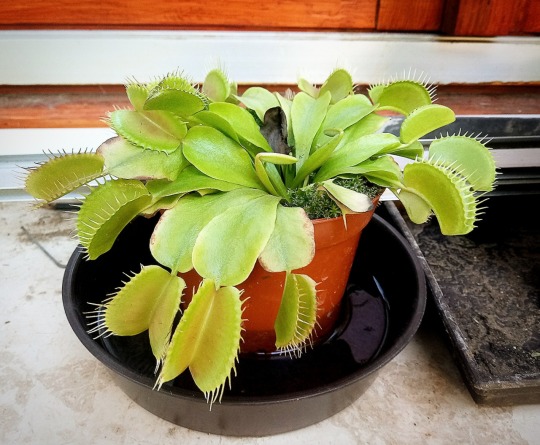
Plants usually resort to eating animals when they live in bogs, where the soil is acidic and extremely poor in nutrients. What bogs also are, is wet, and so these plants need to literally stand in a pool of water all day, every day and are therefore quite literally impossible to over-water. (At least in the summer. Over-wintering depends on whether the plant is temperate or tropical.)
The only downside is that they are really sensitive to water quality. No minerals (and no fertilizer!) allowed, only rain or distilled water!
Marantha leuconeura
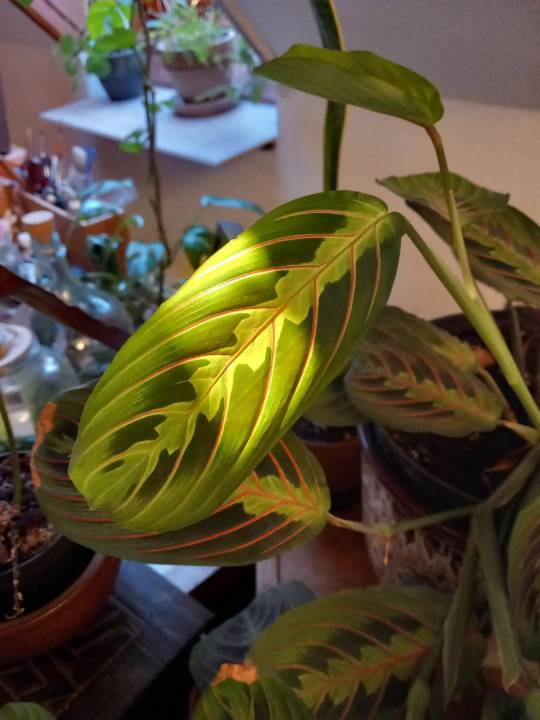
Honestly I’d say the entire Maranthaceae counts, but I only have experience with Marantha, and I’m told the rest (like Calathea) are more difficult. These, once you get the water right (twice a week for me), aren’t that bad. They don’t need a lot of light either.
What you do have to keep in mind, is to give them soft water - like collected rain water. They are sensitive to the minerals in the tap water and since they can’t properly secrete them, they’ll store them away in the tips of their leaves, which will thus crisp up.
Jewel orchids
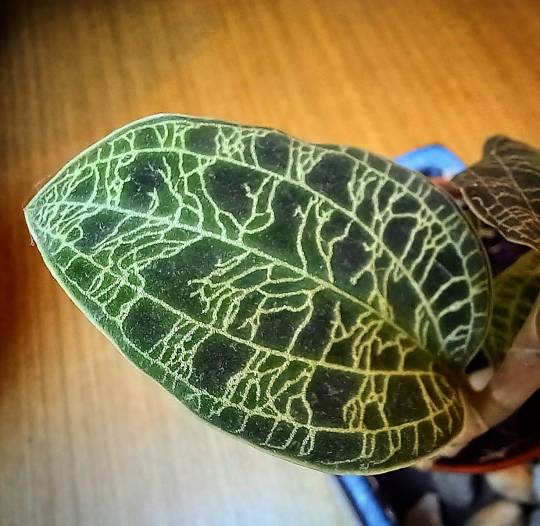
The one I have (Macodes petola) does well in a shadier spot, in normal room conditions. I mean I do run a humidifier once a day, but it’s not in a terrarium. It’d do well in one though, so if you’re looking to furnish a terrarium, this is a good choice. The only thing you gotta keep in mind if you keep it out in your room is to always keep the soil moist.
Mimosa pudica

This is a fun and interesting plant, what with the cute moving leaves, but it is the divaest of all divas. On a sunny, dry summer day it may have to be watered twice a day, and it’ll go into hysterics, crisp up and throw leaves if you’re late by five minutes. The good news is that as long as you do get around to watering it, it’ll bring new shoots and keep growing, it’ll just litter your room with dead leaves in protest.
It also prefers lots of light.
Spathipyllum sp. - Peace Lily

Like ferns, these do well in shadier spots. If exposed to too much light, they’ll keep bringing small, light green leaves, but they’ll flower regularly. (They feel like their lives are in danger so they hurry to procreate before the end.) In the winter they need to be watered about once a week, in the summer more like every two days.
The nice thing about them is that they are very vocal about their needs but, unlike the Mimosa and the Fittonia, don’t immediately, irrevocably crisp up, they’ll just droop. Water them and they’ll perk right back up.
#plant posting#plantblr#plant care#plant community#plant collection#houseplants#indoor plants#fittonia#peace lily#fern#carnivourousplant#marantha#orchid#mimosa
73 notes
·
View notes
Text
I don’t know if it’s just the really overactive empathy shit my brain subjects me to or if I’m just a strange gross person but like office workers throw out so many plants dude I’m so confused
Like 40$ poinsettias at Christmas and today it was a whole ass full size orchid. Like the 30$ full size kind. Like???
The roots are totally fine. The air roots are choked with sphagnum moss but still fat and green. It just doesn’t have any leaves because they cut them off. ??? Like bitch that’s an expensive plant and you’re not even gonna try repotting it?
Wild. Anyways it’s in my backpack and I’m gonna give it a shot
If anyone knows any tips for caring for orchids I’d love to hear em
35 notes
·
View notes